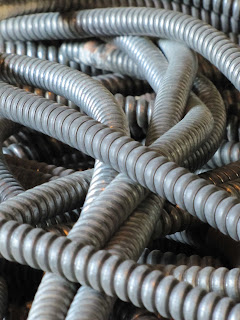9:43 am, April 14th, 2016: I just switched the source of the electricity we buy to 100% wind, thereby (as I understand it) causing a small shift in how Xcel generates power equal to the size of our household electric consumption. Previously, by default, our household’s electricity came from power plants representing Xcel’s
overall mix of generated and purchased electricity: 46.1% Coal, 24.1% Natural Gas, 12.2% Nuclear, 12.2% Wind, 3.5% Hydro, 1.3% Biomass, 0.4% Solar, and 0.2% Other (2013 numbers). According to Xcel and third party
Green-e certification, choosing “
Windsource” will result in wind energy from Minnesota wind farms being added to the grid over and above the level of renewables that Xcel is mandated to provide. This shift will also result in eliminating my household’s part of the carbon dioxide, sulfur dioxide, nitrogen oxides, particulate matter, and mercury emissions from the standard electric fuel mix.
When I flip a switch in our house I often imagine I am turning a power plant on or off. I pretend that lifting or lowering the white plastic lever stops and starts the pollutants coming out of a chimney at some remote industrial site. Of course our home’s electric use is a small part of the total demand, and I can’t literally turn off the pollution like that. But I also know in a way it is real—all those power plants exist in response to all the switches and outlets we control and the energy needed to treat the water we use, and to make the products we buy. I try to conserve energy, but we all use it, and I was looking for a way to make the energy I used more “green.”
The transaction was easy—as convenient as buying any product online. A few clicks and I have stepped a little further away from my relationship with electricity that is powered by nuclear, gas, coal, oil, and trash incineration. Switching is a simple and affordable financial transaction. I could have checked it off my “be greener” list and let it slip by as invisibly as the effects of turning off a light. But this transaction means more to me than that. It means there is a new story behind the wall when I turn on the lights—one that I feel better about. I like to feel connected to the world, to understand the flow between my life and all the man-made and natural systems around me. But feeling this connection through electricity was depressing for me before the switch. Now, once it takes effect, I can better accept my participation in the electric system, imagining that when I flip the switch, somewhere a wind turbine is being constructed and operated in my state, helping a farmer make more profitable use of their land.
Of course, there are challenges to wind energy too. There’s no perfect panacea. I know reducing my electric use is still the best path. But switching to wind is a meaningful step. The meaning of this step is made richer for me by creation of the artwork called “
Switch” which was conceived before I decided to switch to wind. The artwork was a “power contemplation” which in part is about me wanting to feel more connected to the world – including looking at the difficult side of those connections. The artwork is an attempt at communion with the electric landscape. So, why don’t the switches “do anything” in the artwork? Why are the wires clipped, expressing disconnection? There is not one answer, or perhaps any. Experientially, I like the challenge a powerless switch poses to the participant. It raises questions and prompts multiple possible narratives. Do our actions make a difference? Is it too late? Is the switch more internal and personal than external? Is it about saving energy at home? Or changing energy as a society? Or is it reflective of our collective disconnection between action and impact?
It took a long time for me to act. I am behind my greener friends who switched long ago. I have worked in energy analysis and intellectually knew this was a good step. I have thought about it for years. Perhaps my delay is due to the abstraction of energy sourcing, or because I place higher priority on energy conservation, or simply my inertia.
The Switch artwork was a ritual object for me, nudging me to decide to switch to wind, and helping me to honor that decision as more than an online purchase. But it also helped me connect with and appreciate the troubled past of my own electric use, which I’ll write about in other posts.




















